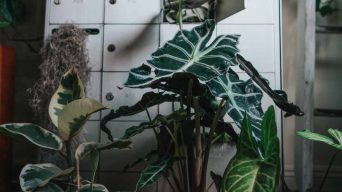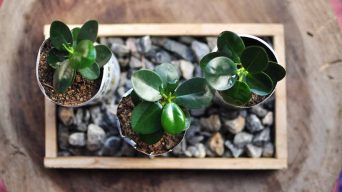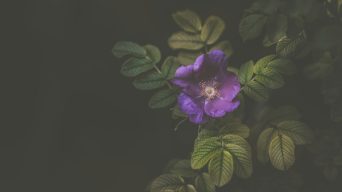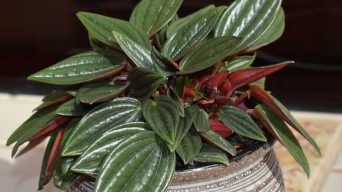Key Takeaways
- Pruning is essential for maintaining the health and appearance of Peperomia plants. It encourages new growth, removes dead or diseased parts, and promotes fuller, bushier growth.
- Timing is crucial when it comes to pruning Peperomia plants. Generally, the best time to prune is spring and summer when they are actively growing.
- To effectively prune Peperomia plants, you will need sharp pruning shears, disinfectant for your tools, and protective gear such as gloves and eye protection. Proper clippings disposal can also prevent disease spread in other plants.
- Common mistakes include over-pruning or under-pruning, which can be detrimental to the overall health of your plant. Additionally, pruning at the wrong time (such as during winter) should be avoided to prevent shock and stress on your Peperomia plant.
Peperomia plants, also known as radiator plants, are popular houseplants that come in various shapes and sizes.
These low-maintenance beauties thrive in various environments, making them an excellent choice for both experienced plant owners and beginners.
One vital aspect of Peperomia care is proper pruning, which helps maintain their size and appearance and promotes healthy growth.
In this guide to pruning Peperomia plants, we will walk you through the importance of pruning, the tools needed for success, and a step-by-step approach to do it effectively.
Why Pruning Is Essential For Peperomia Plant Care
Maintaining the shape, encouraging new growth, and getting rid of any dead or diseased parts that may harm the plant’s overall health are all reasons why pruning is crucial for Peperomia plant care.
Benefits Of Pruning
Pruning your Peperomia plant offers numerous benefits to its overall health and appearance.
One significant advantage of pruning is that it encourages fuller, bushier growth.
Another benefit of regular pruning is the removal of any damaged or diseased leaves and stems.
This helps maintain the aesthetic appeal of your Peperomia and prevents the spread of disease and pest infestations within your plant collection.
For instance, if you notice irregular black spots on your Watermelon Peperomia’s leaves (caused by a fungus), promptly trimming away affected areas can prevent further damage and keep the problem under control.
When To Prune Peperomia Plants
Timing is crucial when pruning your Peperomia plants, as it can significantly impact their health and appearance.
Generally, the best time to prune these popular houseplants is spring and summer.
It’s essential to monitor your peperomia plant closely as the weather gets warmer, checking for any signs that may indicate it needs trimming – such as leggy stems or excessive foliage growth.
For instance, if you notice that your radiator plant has produced abundant leaves but lacks balance due to overgrown stems or branches, this is a clear sign that it’s ready for pruning.
By keeping track of these subtle changes in your beloved indoor plant’s appearance, you can ensure its optimal growth throughout the year while maintaining its decorative addition status within your home or office space.
Understanding Peperomia Plant Growth
Peperomia plants, also known as radiator plants or baby rubber plants, are an excellent choice for plant enthusiasts due to their ability to adapt to various environments and thrive under diverse conditions.
One key aspect of Peperomia plant growth is its tendency to have a bushy appearance with thick stems and fleshy leaves.
The foliage of these tropical plants stores water much like succulents, enabling them to tolerate periods of drought.
As such, they prefer well-draining soil mixtures that don’t retain too much moisture.
Regarding watering practices, peperomias generally require less frequent watering than other houseplants due to their succulent-like characteristics; overwatering can lead to root rot and other diseases.
Additionally, proper pruning techniques aid in promoting healthy growth by removing dead or diseased leaves and encouraging branching at the stem level.
Tools You Need To Prune Peperomia Plants Effectively
To prune Peperomia plants properly, it is important to select appropriate pruning shears, sanitize your tools, and prioritize safety by wearing protective gear.
Choosing The Right Pruning Shears
A good pair of pruning shears is one of the most important tools you will need when pruning your Peperomia plants.
These specialized scissors allow for more precise cutting, especially in hard-to-reach areas.
When choosing pruning shears, look for those that are sharp and durable.
Opting for high-quality pruners will save you time and money in the long run as they last longer and require less frequent sharpening.
Additionally, consider how comfortable the shears feel in your hand and if they fit well with your hand size.
Disinfecting Your Tools
Before you begin pruning your Peperomia plant, it is crucial to disinfect your tools properly.
This step helps prevent the spreading of diseases that can affect your plant’s health and growth.
To disinfect your pruning shears, wipe them down with a cotton tab dipped in rubbing alcohol or hydrogen peroxide.
Additionally, wear gloves while handling your Peperomia plant to avoid any potential skin irritation or injuries from accidental cuts.
Wearing Protective Gear For Safety
Before pruning your Peperomia plants, it’s essential to wear protective gear for safety purposes.
Wearing gloves and eye protection can help prevent injuries while handling sharp pruning shears or accidental debris from flying into your eyes.
Additionally, wearing a mask can protect your airways from harmful fumes if you use chemicals such as disinfectants or pesticides during pruning.
As an added precaution, properly store all tools away from children or pets when not in use.
Step-by-Step Guide To Pruning Peperomia Plants
In this section, you will find a comprehensive guide on effectively pruning Peperomia plants.
The guide covers various aspects, such as identifying the plant’s needs, determining which parts to prune, making clean cuts, and using a disinfectant on tools after pruning.
Identify The Plant’s Needs
Before you start pruning your Peperomia plant, assessing its needs is important.
Understanding the specific requirements of your plant will help determine how much and where to cut.
For example, some Peperomia species thrive in bright indirect sunlight, while others prefer lower light levels.
Take note of any problem areas or growth patterns that also need correction.
Sparse growth may require more extensive pruning to promote bushier foliage, while an overgrown pot may need a larger container for root expansion.
Determine Which Parts To Prune
Before pruning your peperomia plant, determine which parts require trimming.
Start by identifying any dead, diseased, or damaged leaves first.
These should be pruned off immediately to prevent the spread of disease and insects.
Next, consider pruning back stems that are too long (leggy) or out of place, such as those growing in an erratic direction.
Look for areas where the stem has multiple buds and prune just above a bud facing inwards so that new growth occurs instead of outwards.
If you have a bushy peperomia variety like Peperomia obtusifolia, you should shear it lightly on top once every few weeks to maintain its shape and encourage new growth from the base.
Prune Damaged Or Diseased Leaves
Pruning away any damaged or diseased leaves is essential to maintaining the health and appearance of your Peperomia plant.
If you notice any browning, spots, or discolorations on the foliage, it’s time to take action.
Use clean pruning shears to snip off affected parts of the plant carefully.
Be sure to cut back far enough that no evidence of disease is left behind.
Properly disposing of these clippings will help prevent further spread of illness throughout your other plants.
Consider The Plant’s Shape And Size
When pruning your Peperomia plants, it’s essential to consider their shape and size.
This will help you determine which plant parts need to be pruned, giving it a more aesthetic look.
Peperomia plants come in different shapes and sizes, with some having round leaves while others have elongated foliage.
Pruning can help maintain its compact form by removing any leggy growth for plants with a bushy appearance, like the Watermelon Peperomia.
On the other hand, for trailing varieties such as the Prostrata Peperomia, trimming can keep its stems from becoming spindly and sparse.
Make Clean Cuts
When pruning your Peperomia plant, it is crucial to make clean cuts.
This means using sharp pruning shears and carefully not damaging any surrounding foliage or stems.
Clean cuts allow the plant to heal quickly and prevent unnecessary stress on the plant.
Making clean cuts also includes only cutting what needs to be pruned.
It’s important not to cut off too much of the plant at one time, as it can shock the system and lead to stunted growth or even death in severe cases.
Prune To Propagate
One of the benefits of pruning peperomia plants is that it allows you to propagate new plants.
Propagation involves taking a cutting from the plant and replanting it to grow into a new individual.
Depending on the species, Peperomia plants can be propagated through leaf cuttings and stem cuttings.
For example, watermelon peperomia can be propagated by planting leaf cuttings in potting soil and keeping them moist until roots form and new growth appears.
Meanwhile, Ruby Glow Peperomia can be propagated by taking stem cuttings with at least two leaves attached, dipping the end in rooting hormone powder, and placing them in moist soil until roots develop.
Use Disinfectant On Tools After Pruning
After pruning your Peperomia plants, using a disinfectant on your tools is crucial.
This will help prevent the spread of harmful microorganisms that may cause disease or damage to your plant.
Ensuring your tools are clean and disinfected before and after use is essential for maintaining healthy Peperomia plants.
Neglecting this step could lead to the introduction of bacteria or fungi, which can harm your beloved plant in significant ways.
Common Mistakes To Avoid When Pruning Peperomia Plants
When pruning Peperomia plants, it’s important to avoid over-pruning, under-pruning, pruning at the wrong time, and improper disinfection of tools.
Over-Pruning
Over-pruning is a common mistake when it comes to Peperomia plant care.
While pruning can encourage stem growth and keep the plant in shape, too much pruning may cause stress and hinder its growth.
It is essential to avoid cutting more than one-third of the plant at a time as it can harm your Peperomia.
One way to prevent over-pruning is by observing how your Peperomia plants respond after each trimming session.
If you notice stunted or no new growth, it may be a sign that you have pruned too much.
Under-Pruning
One of the common mistakes when pruning Peperomia plants is under-pruning.
Under-pruning occurs when only a few parts or none are removed during the pruning process.
This can lead to overgrowth, which can cause issues such as uneven shape and size for the plant and crowding of leaves around certain areas.
To avoid under-pruning, identify the specific needs of your Peperomia plant before starting the pruning process.
You must determine which specific areas require pruning based on its overall condition.
Also, remember that regular and thorough pruning will encourage new growth while keeping old parts healthy and rejuvenated.
Pruning At The Wrong Time
Pruning at the wrong time is a common mistake that plant owners make with their Peperomia plants.
For instance, pruning during the winter months can harm your plant’s health as it may cause shock and stress.
It is crucial to know when to prune Peperomia plants and do it during the growing season, spring and summer.
Pruning during this period encourages new growth and helps shape your plant.
Additionally, pruning at the right time allows wounds to heal quickly, as there are enough resources for repairing damages caused by cutting.
Improper Disinfection Of Tools
One of the most common mistakes when pruning peperomia plants is improper disinfection of tools.
Disinfecting your pruner before cutting off rotten roots and unwanted leaves is crucial as it helps prevent the spread of diseases from one plant to another.
To ensure proper disinfection, dip your tools in rubbing alcohol before using them.
Additionally, wet a cotton tab with plant-safe disinfectant and wipe the entire plant surface before starting to prune.
Remember to also disinfect the pot before repotting your plant for better results.
Final Thoughts
Pruning your Peperomia plants is a crucial step in their care routine that will keep them healthy and looking great.
By understanding the right tools to use, timing, and techniques for cutting, you’ll be able to prune like a pro!
Remember to wear proper protective gear and disinfect your tools beforehand.







